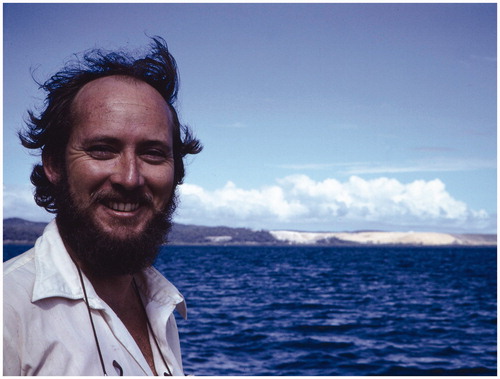Rob Neal, with North Stradbroke Island and the Wallen Wallen Creek site in the background, 1987 (photograph by Ian J. McNiven).

Archaeologist Robert ‘Rob’ Neal passed away at his home in Alstonville, northern New South Wales earlier this year.
Rob was born and grew up in Grafton, New South Wales. Enrolling at the University of New England in 1978, he graduated BA in 1981 and BA (Hons) in 1982. His honours thesis, written under the supervision of Harry Lourandos, was an analysis of the invertebrate fauna of the Carlton Bluff site in southeast Tasmania (Neal Citation1981).
In 1983, Rob commenced a PhD within the then Department of Anthropology and Sociology at The University of Queensland under the supervision of Jay Hall, where he was a student until 1989. Rob’s archaeological thesis focused on shedding new light on past Aboriginal use of North Stradbroke Island, Moreton Bay, southeast Queensland, through excavation and analysis of midden sites at Blue Lake and Wallen Wallen Creek. The latter site, on the west coast of North Stradbroke Island, revealed stone artefacts extending for over 1.5 m below midden deposits. To Rob’s and everyone’s astonishment, charcoal associated with the lowest stone artefacts dated back to 20,560 ± 250 (SUA-2341) which calibrates to c.24,700 cal BP (Calib 7.0). This date provided the first evidence of Pleistocene occupation of Australia’s east coast north of the Sydney region. The significance of the site and its early date resulted in a letter in Nature co-authored with geomorphologist Errol Stock (Neal and Stock Citation1986). Unfortunately, Rob never had an opportunity to complete analysis of materials excavated from Wallen Wallen Creek. Despite this void, the Wallen Wallen Creek Nature paper singlehandedly transformed coastal archaeology in southeast Queensland. Although Rob authored numerous consulting reports and co-authored one other academic publication (Ulm et al. Citation1995), his Nature paper, now over 30 years old, stands as his crowning academic achievement with implications that reverberate through to the present.
In 1985, Rob established his own cultural heritage consulting company, Pirripoint Ltd, and undertook numerous archaeological projects across Queensland. In the second half of the 1980s, Rob also was manager of the UQASU (University of Queensland Archaeological Services Unit). Rob later worked in the Cultural Heritage Branch of the then Queensland Department of Environment and Heritage. He was a staunch advocate for Indigenous cultural heritage, often in difficult circumstances and was the instigator of a number of actions to record and, where possible, preserve, important archaeological sites and landscapes.
A meticulous excavator who kept detailed fieldnotes, ill health unfortunately ended Rob’s professional career early. Despite this set back, Rob retained an abiding interest in archaeology and was always willing to help a student or colleague. Indeed, in the months preceding his passing he assisted a number of people with information about his past research in Torres Strait and southeast Queensland.
Rob will be remembered by his close colleagues as a man of intellect and integrity, an empathetic soul with compassion for fellow archaeologists and their families. He enjoyed a beer and a laugh, especially if they accompanied deep philosophical conversations about archaeology. For those of us who had the pleasure of knowing Rob either as a fellow PhD student or in a work capacity in the 1980s and 1990s, we have lost a loyal and generous mate and a fine mind.
Rob is survived by his children Alexander and Emma and sisters Diane Carr and Donna Green.
References
- Neal, R.A. 1981. Carlton Bluff: an analysis of the invertebrate fauna from a lower estuarine shell midden site, South East Tasmania. Unpublished BA(Hons) thesis, University of New England, Armidale.
- Neal, R. and E. Stock 1986 Pleistocene occupation in the south-east Queensland coastal region. Nature 323(6089):618–621.
- Ulm, S., B. Barker, A. Border, J. Hall, I. Lilley, I. McNiven, R. Neal and M. Rowland 1995 Pre-European coastal settlement and use of the sea: a view from Queensland. Australian Archaeology 41:24–26.
